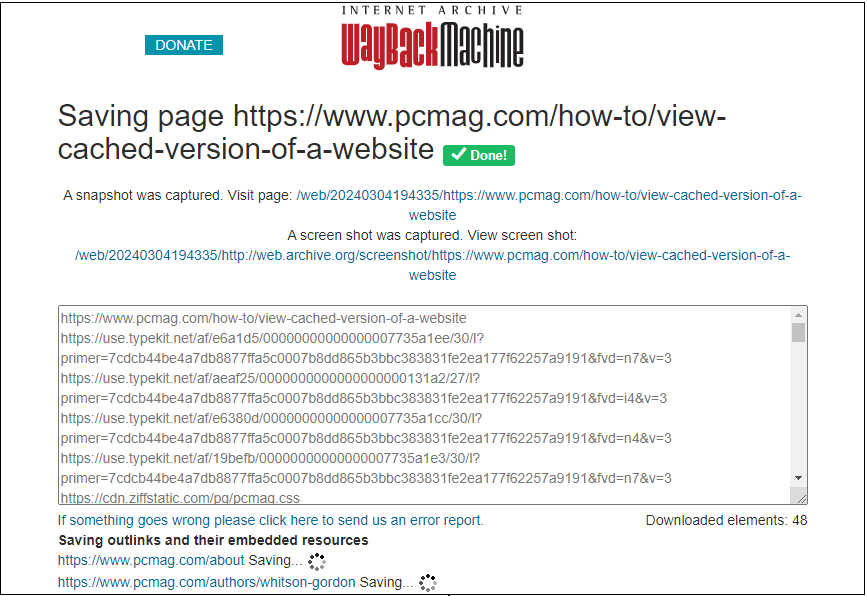It's easy to forget the impermanence of the internet. Pages are updated constantly, articles are taken down without warning, and entire websites disappear overnight. It's estimated that 66% of all page links on the web since 2013 are now dead, a phenomenon known as link rot.
There are plenty of reasons you might lose access to a specific web page. The servers could be down or the site owner has altered (or removed) the content you're trying to find. In these cases, it's worth checking to see if a cached version still exists.
Google used to save backup copies of the web pages it indexed, but the option to view a cached version of a web page from search results has been removed. “It was meant for helping people access pages when way back, you often couldn't depend on a page loading. These days, things have greatly improved. So, it was decided to retire it,” Google's official search liaison, Danny Sullivan, said in February 2024.
It's a puzzling move, but Google has never been shy when it comes to sunsetting products. Still, the search giant is not giving up completely on archived content. Google is partnering with the Internet Archive to offers links to its Wayback Machine directly from search results. There are other options, too. Here's how to access a cached version of a web page.
View a Cached Web Page on Google
 (Credit: PCMag / Google)
(Credit: PCMag / Google)To access an archived website in Google, click the three-dot icon next to the result you want to view. Click the More about this page button, scroll down to the bottom of the page, and click see previous versions on Internet Archive's Wayback Machine to view the most recent cached version of the site.
 (Credit: PCMag / Google)
(Credit: PCMag / Google)Note: while the caching is handled by the Wayback Machine, the cached version that opens doesn't give you unfettered access to the full archive of the site. If you're looking to delve into the history of a certain web page or website, you'll need to use the Internet Archive directly (more on that belows).
View a Cached Web Page on Microsoft Bing
 (Credit: PCMag / Microsoft)
(Credit: PCMag / Microsoft)Microsoft's Bing offers a similar feature that allows you to view saved versions of the sites you're trying to visit. Viewing a cached website on Bing is similar to how Google used to do it. From the search result page, click the down arrow next to the entry you wish to access, and select Cached from the menu.
 (Credit: PCMag / Microsoft)
(Credit: PCMag / Microsoft)You will be taken to the page in question with a notice at the top to indicate it's the snapshot of the page from the last time Bing crawled the website. (Note that this process will also work with Yahoo! Search, since Microsoft Bing handles the web crawling for Yahoo!)
Search a Website's History With the Wayback Machine
 (Credit: PCMag / Internet Archive)
(Credit: PCMag / Internet Archive)If you're looking for historical data on a frequently scraped website, a cached version won't be particularly helpful. For a bigger picture of a website over time, the nonprofit Internet Archive hosts websites, texts, video, audio, software, and images that can be hard to find anywhere else. And its Wayback Machine, which works for existing and dead websites, lets you view snapshots of them over time.
 (Credit: PCMag / Internet Archive)
(Credit: PCMag / Internet Archive)Enter the URL you want to explore, and the archival search engine will show a calendar that indicates when the Wayback Machine crawled that page. Click a date on the calendar to see what the site looked like on that day. The Wayback Machine is a great way to view the history of the internet; archived versions of PCMag.com date back to Dec. 19, 1996!
Don't want to wait for the Wayback Machine to work its magic? If you have a web page that you want to preserve for future generations, you can also manually archive it from the Wayback Machine homepage. Paste the URL into the text field under Save Page Now and click Save Page.
 (Credit: PCMag / Internet Archive)
(Credit: PCMag / Internet Archive)If you have an Internet Archive account, you can also save a screenshot of the page and create an archive of any other pages it links out to. Make your choices, click Save Page again, and wait for the archive to be generated.
Don't want to visit the site directly? The Internet Archive also offers Wayback Machine browser extensions for Chrome, Edge, Firefox, and Safari, which allow you to search the archive right from the website in question.
Archive.Today
 (Credit: PCMag / Archive.Today)
(Credit: PCMag / Archive.Today)The archiving website Archive.Today allows users to save the most current version of a web page and also search for existing entries that have previously been saved. Enter a URL into the red text box to archive an existing page. If an archive has been created recently, you will have the opportunity to review it and save a new one.
 (Credit: PCMag / Archive.Today)
(Credit: PCMag / Archive.Today)If you want to view archived versions of a website, enter the URL in the blue text box and Archive.Today will populate results for that page and its associated domain. If there are multiple versions of the same page, they will be stacked together for easy viewing. You can then download a zip file of the web archive. PCMag's website, for instance, is archived as far back as January 31, 2013 and currently has nearly 70 different versions of the homepage saved on the service.
Unofficial browser extensions have been created for Chrome, Edge, Firefox, and Safari that allow you to archive a page with the click of a button.

